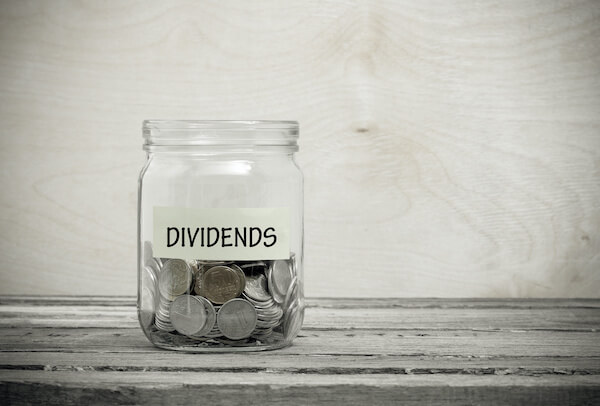
If you’re looking for stocks that pay an attractive dividend rate, join the club.
Investors want investments that don’t just appreciate in value but also generate regular income. Stocks that pay a competitive and sustainable dividend rate can be the ideal solution.
In this guide to dividends, we’ll quickly review how dividends work, what you need to know about dividend rates, the difference between dividend rate and dividend yield, and how to find stocks that pay competitive and sustainable dividends.
How Do Dividends Work?
Dividend stocks share a portion of the company’s earnings with investors on a regular basis. The dividends are determined by the company’s board of directors.
Most dividend stocks pay a set amount of dividends each quarter. Some even increase the dividend payout over time, which enables investors to enjoy an increasing cash stream.
Investors who don’t need to tap into the cash provided by dividends can choose to reinvest dividend income to take advantage of the benefits of compounding. In other words, when you reinvest the dividend payment, you’re essentially creating a really awesome cycle for yourself by buying more and more stock, which means an increase in future dividends.
Typically, the companies that pay dividends are well-established, so owning dividend stocks can provide some welcome stability to your investment portfolio.
Companies that generate significant cash flow tend to pay dividends. On the other hand, organizations experiencing rapid growth typically do not pay dividends because they need to reinvest the majority of the cash they generate back into the company.
Take Tesla (NASDAQ:TSLA), for example, who says, “We intend on retaining all future earnings to finance future growth and therefore, do not anticipate paying any cash dividends in the foreseeable future.”
What Is Dividend Rate?

The dividend rate is essentially a way to compare dividends paid out in a year’s time by different companies. But it’s important to understand that a stock with a higher dividend rate doesn’t mean you’ve found the perfect stock. There is much more to it.
A company’s dividend rate is the total expected dividend payments — presented on an annualized basis — plus any additional nonrecurring dividends that an investor may receive.
So, to calculate dividend rate, multiply the most recent dividend payments by the number of payment periods in one year.
Dividend rate = (most recent dividend payment x number of payment periods in one year) + nonrecurring payments
For example, if a dividend stock pays a dividend of 10 cents per share quarterly and also pays an extra dividend of 2 cents per share because of a nonrecurring event from which the company enjoyed a significant benefit, the dividend rate is $0.42 per year (10 cents x 4 quarters + 2 cents = $0.42).
In July 2021, Apple’s (NASDAQ:AAPL) dividend rate was $0.88 per share. That’s on an annualized basis. Apple pays a quarterly dividend of $0.22 per share. Multiply that by four quarters, and you get $0.88. If you own 100 shares of Apple, you multiply the dividend rate by the number of shares. Now you know you can expect $88 ($0.88 per share times 100 shares) of dividend income per year.
Different companies, of course, approach dividends differently. So depending on the company’s individual strategy, the dividend rate might be quarterly, annual, fixed, or adjustable.
Think of dividend rate as an estimate of the dividend-only portion of your return on investment, or ROI.
Dividend rate is sometimes confused with dividend yield. So let’s take a quick look at the differences.
Dividend Rate vs. Dividend Yield: What’s the Difference?
Dividend rate is always expressed in dollars, and dividend yield is always a percentage. But that’s not the only difference.
While dividend rate tells you how much you’ll earn in a given year, dividend yield will help you understand how much your investment will yield you over the long run.
Dividend yield is a relative term since this rate of return is calculated as a percentage of your initial investment. In other words, if you invest $10,000 in a dividend-paying stock, it’s important to understand what dollar amount you can expect to generate from that $10,000.
To calculate dividend yield, you take the latest annual dividend and any special dividends if there were any (or the dividend rate) and divide that sum by the current share price.
Dividend yield = dividend rate / current market price
In July 2021, Apple’s dividend yield was 0.59%. Dividends for the year were $0.88, and the market price was $148. So $0.88 / $148 = 0.59%.
Buyers beware! Because of the nature of the dividend yield formula, high dividend yields result when the dividend payout is high but also when the price of the stock is low. This also means that solid dividend stocks can have low dividend yields because their share prices are climbing.
This is something you’ll often see with stocks that have a track record of strong performance and dividend growth, like the Dividend Aristocrats.
Other Things to Consider When Looking for Dividend Stocks

The main appeal of dividend stocks is their predictability. Investors love the idea of getting a periodic cash payment. However, dividend stocks are not without risk. If a company runs into financial difficulty and has to slash the dividend, the stock price is going to drop quickly.
Building a portfolio of stocks that pays sustainable dividends requires time and effort, but it can be done. Whether you’re investing in individual stocks, mutual funds, or exchange-traded funds (ETFs), the process is generally the same.
First, identify a dividend-paying stock or fund that aligns with your investment objectives.
Of course, the dividend rate and dividend yield are not the only considerations. So the next step is to evaluate the investment using a few additional metrics:
- Dividend growth: What is the company’s track record when it comes to sharing an increase in earnings with investors? A good place to find stocks with strong dividend growth is a group known as the Dividend Aristocrats, which is a group of S&P 500 stocks that have raised dividend payouts for at least 25 consecutive years.
- Dividend sustainability: Take a look at the stock’s dividend payout ratio over an extended period of time. Payout ratio is the percentage of profits that a company spends on dividends. How is the company performing when it comes to competition? Is the company in an industry that’s growing or shrinking?
- Debt and credit rating: Financial strength is important. What kind of debt does the company carry? Is it reasonable compared to industry standards? Take a look at the investment-grade credit rating to understand whether the company has enough cash and working capital to weather unexpected economic events.
Learn More About the Best Dividend Stocks
Choosing the right dividend stocks for retirement is not as easy as simply looking at the dividend rate. And dividend investing is not without risk. Understanding factors like yield, growth, and credit rating are also important.
Careful research is always a good idea before moving ahead with any dividend stock purchase. To learn more about specific dividend stocks that could be the cornerstone of your retirement strategy, subscribe to Investors Alley’s “Dividend Hunter” newsletter.





